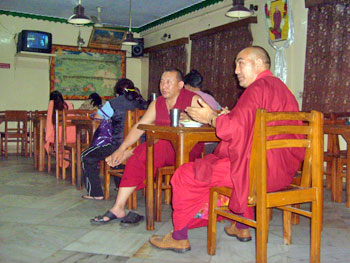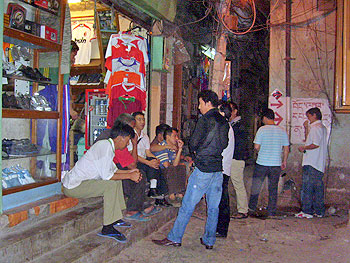
Tibetan Buddhist monks at the Tibetan restaurant at Gyudmed Monastery Dharamsala in Delhi
This evening Felix and I walked down to Tibetan Market for some Tibetan fare. Yes, entering Tibetan Market is a different world altogether. Apart from the funky tees, jeans and boots for sale, there’s more than what just meets the eye. More than pretty faces that make your heads spin around, it’s the old wrinkled face that captivates your attention. The sedate red-robed monks and nuns call you to reverence.
Tibetans in Delhi have had a long history. After the Chinese invasion of Tibet in 1950 and the subsequent Tibetan Uprising of 10 March 1959, the Dalai Lama along with some more Tibetans fled into India. Incidentally, tomorrow is the 50th anniversary of this great Uprising. The Tibetans tell me that they have planned to fast and march from Raj Ghat to Jantar Mantar to express their solidarity for a Free Tibet.
Interacting with a group of Tibetans chatting up their evening, you marvel at their easy candour and resilience. You easily feel welcomed by such peace-loving people. However, this doesn’t seem to be easy peace. Being displaced from their homeland, the Tibetans are now refugees in a land they struggle to call their own. The old wrinkled faces tell a narrative of resistance writ large on their faces. Having been born in Tibet, their sense of alienation is strong. The young, who are born in India and yet still claim to be Tibetans — though some may not have even visited their homeland — face a deeper sense of alienation. Like most displaced people within our own country, they long for a place called home.
Along with their identity, the Tibetans find their religion threatened. Way back in the 1950s itself, the Chinese invasion destroyed thousands of monasteries and temples belonging to Tibetan Buddhism. The Dalai Lama, the spiritual head of Tibetan Buddhism, is himself in exile in India. On the other hand, the Panchen Lama has been taken custody by China. Brutalities by the Chinese military against monks and nuns belonging to Tibetan Buddhism still continue today.

Tibetans at the Tibetan market
Right from the Tibetan Uprisings of 10 March 1959, 1989 and 2008, the cause of Tibetan liberation from the Chinese invasion has garnered international attention. It’s 50 years now and yet no country has had the will to challenge China for unjustly invading another country. As Tibet garners support to mark 50 years of its 1959 Uprising, China has already imposed a lockdown and severe martial law in Tibet. Surely Tibetans don’t call us to march and directly confront the Chinese government in its doorsteps. But raising your voice in support of Tibet itself will likely advance the pressure on China to free Tibet. A free and resurgent Tibet will also be in our own interest. Tibetan Buddhism which is, besides religion, a way of life teaches us the path of peace and co-existence that is so badly needed in our own fragmented world and country.
Walking back home, Felix and I realised that Tibetan market is more than just momos, thukpas and tsampas. It is definitely more than attire. It is more than a pretty face. It is rather a struggle of the wrinkled face calling you to join the chorus and shout: FREE TIBET!